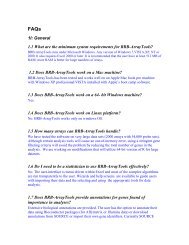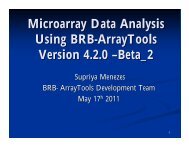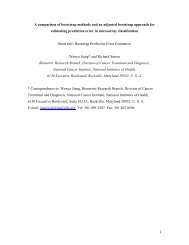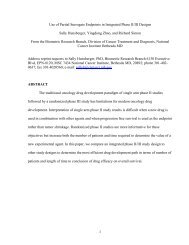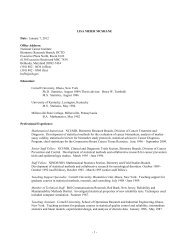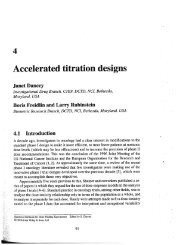Identification of Pharmacogenomic Biomarker Classifiers in Cancer ...
Identification of Pharmacogenomic Biomarker Classifiers in Cancer ...
Identification of Pharmacogenomic Biomarker Classifiers in Cancer ...
Create successful ePaper yourself
Turn your PDF publications into a flip-book with our unique Google optimized e-Paper software.
Simon and Maitournam consider use <strong>of</strong> the Targeted Design shown <strong>in</strong> Figure 1. Dur<strong>in</strong>g<br />
pre-cl<strong>in</strong>ical and phase I/II cl<strong>in</strong>ical development one identifies a fully specified classifier<br />
<strong>of</strong> which patients have a high probability <strong>of</strong> respond<strong>in</strong>g to the experimental drug. That<br />
classifier is then used to select patients for phase III trial. This is a form <strong>of</strong> enrichment<br />
design. Table 1 shows the number <strong>of</strong> events required <strong>in</strong> order to have 80% statistical<br />
power for compar<strong>in</strong>g exponential survival times us<strong>in</strong>g the design <strong>of</strong> Figure 1 if the<br />
treatment results <strong>in</strong> a halv<strong>in</strong>g <strong>of</strong> the hazard <strong>in</strong> the patients selected for study us<strong>in</strong>g the<br />
classifier. The number <strong>of</strong> events shown <strong>in</strong> Table 1 is compared to the number <strong>of</strong> events<br />
required <strong>in</strong> a standard cl<strong>in</strong>ical trial if the classifier is not used to select patients for<br />
randomization (Table 2). The table assumes that the treatment is not effective for the<br />
classifier negative patients. More extensive results on relative efficiency <strong>of</strong> the targeted<br />
and untargeted designs are described by Simon and Maitournam {Maitournam, 2005<br />
#207; Simon, 2004 #160}.<br />
For many molecularly targeted drugs, however, the appropriate assay for select<strong>in</strong>g<br />
patients is not known and development <strong>of</strong> a classifier based on compar<strong>in</strong>g expression<br />
pr<strong>of</strong>iles for phase II responders versus phase II non-responders may be the best approach.<br />
In such <strong>in</strong>stances, one may not have sufficient confidence <strong>in</strong> the genomic classifier<br />
developed <strong>in</strong> phase II to use it for exclud<strong>in</strong>g patients <strong>in</strong> phase III trials as <strong>in</strong> Figure 1. It<br />
may be better <strong>in</strong> this case to accept all conventionally eligible patients, and use the<br />
classifier <strong>in</strong> the pre-def<strong>in</strong>ed analysis plan.<br />
16



